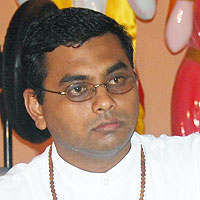From a satsang with Pt. Umadutt Maharaj, Spiritual Leader, SWAHA Bhakti Jyot Mandali
In the Bhagavad Gita, Chapter 2, Shree Krishna says, “The unreal has no existence, and the real never ceases to be; the reality of both has thus been perceived by the seers of Truth. Know that alone to be imperishable which permeates this universe; for no one has power to destroy this indestructible substance.”
Bhagavan Shree Krishna teaches us that the wise one does not get deluded over pain or happiness. He says that we tend to grieve over those who should not be grieved for. Instead, the wise one does not sorrow over the dead or the living. He explains the rationale: “In fact, there was never a time when I was not, or when you or these kings were not. Nor is it a fact that hereafter we shall all cease to be.” This particular verse speaks of the cosmological principles of reincarnation and karma. Shree Krishna has always existed, as have all the kings in the Bhagavad Gita, as well as you and I. We have all existed before in some other time, circumstance, name and form. We have all exited life in the past, and whatever karmas we performed then, have determined the circumstances of the new reincarnation.
“Just as childhood, youth and old age are attributed to the soul through this body, even so, it attains another body. The wise man does not get deluded about this.” The soul is not subjected to change. It is the body that is subjected to the cycle of birth and death. It is subjected to the various modifications of birth, growth, maturity, decay and death. The body consists of five sheaths: the annamaya kosha (food sheath), the manomaya kosha (mind sheath), the praanomaya kosha (the vital airs sheath), the vigyaanomaya kosha (the knowledge sheath) and the aanandamaya kosha (the bliss sheath).
“The unreal has no existence.” It is that which is temporary and changing; it consists of everything around us in the world of matter. The body and soul co-exist but, at some point, the soul must release the body. Even the highest forms of creation must someday end. It is said that the only constant is change. The real, however, never ceases to be; it is the soul in each of us, to which we reverently pray: “Antar Jyothi namo, Paramaatmaa Jyothi namo, Jeevan Jyothi namo” (I bow to the inner light, the soul).
Even after the physical body has died, the soul takes on other bodies in the cycle of birth and death. We express sorrow and experience the various emotions associated with death because of our sense of attachment. We perceive each other through our physical senses and have labelled these relationships as family or friend. However, the journey of life is towards that realization that the soul does not perish, and it permeates this entire universe. It is indestructible and it is the Truth.
“This soul is never born, nor does it die… it is unborn, eternal, everlasting and ancient; even though the body is slain, the soul is not.” The man who realises that this soul is eternal and free from birth and decay, is free from bondage. “As a man shedding worn-out garments, takes other new ones, likewise, the embodied soul, casting off worn-out bodies, takes on others that are new.” We are all here in this present life because we are reaping the stored-up karmas (prarabdha karma) that we have created in past lives. Such karma can only be experienced and exhausted. However, this life also presents us with the opportunity to perform service to humanity. Thus, by performing the right karmas, we can create better circumstances for ourselves in the future, and advance further towards the spiritual goal of realizing the Supreme.



